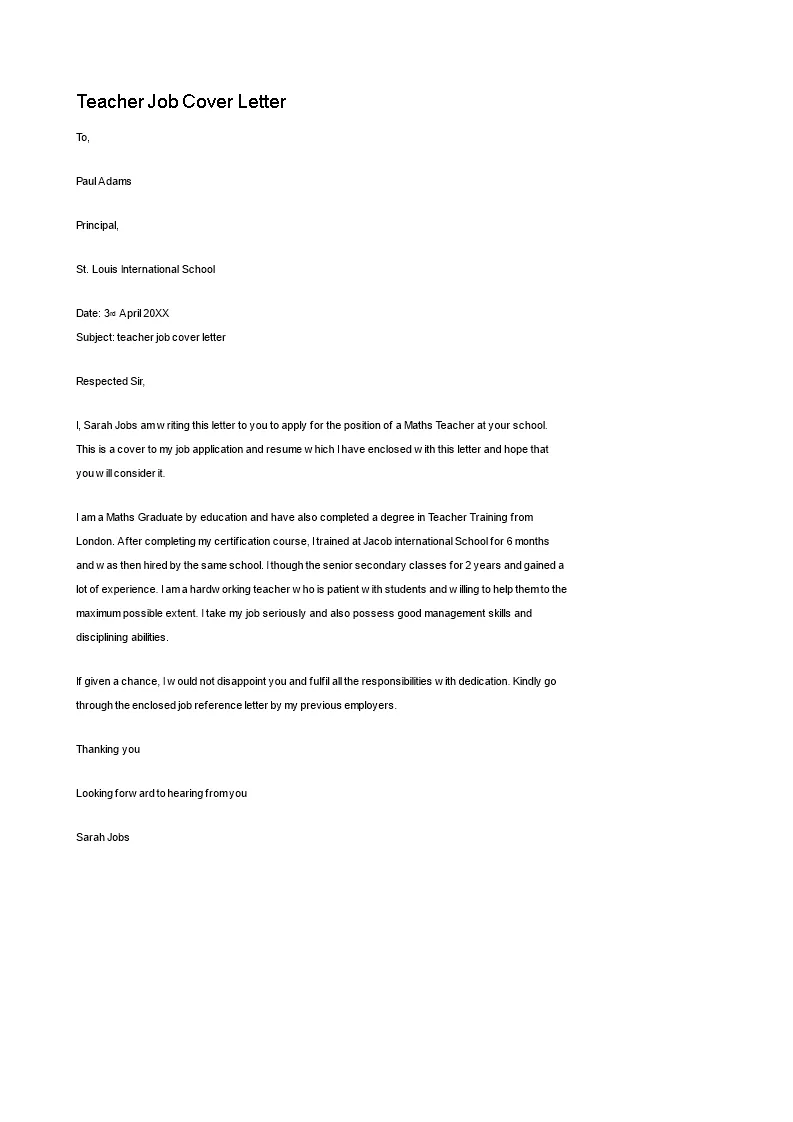Why a Teacher Cover Letter Matters
A well-crafted cover letter is your initial introduction to the hiring committee, setting the stage for your entire application. It’s not just a formality; it’s a crucial opportunity to showcase your unique qualifications, skills, and personality, which go beyond what a resume can convey. Think of it as your personal sales pitch, designed to persuade the reader that you’re the ideal candidate. A strong cover letter helps you stand out from the multitude of other applicants vying for the same teaching position. It gives you a space to highlight your teaching philosophy, explain why you’re passionate about education, and demonstrate how your experiences align with the school’s specific needs and values. A compelling cover letter is often the key to getting your foot in the door and securing an interview. It also lets you address any potential concerns the hiring manager might have based on your resume.
Highlighting Your Teaching Skills
When detailing your teaching skills in a cover letter, go beyond simply listing them; provide specific examples of how you’ve utilized these skills to achieve positive outcomes. For instance, instead of stating that you have strong communication skills, describe a situation where you effectively communicated complex concepts to students, resulting in improved comprehension and engagement. Focus on skills such as lesson planning, differentiation, assessment, and classroom management. If you’re proficient in using educational technology, be sure to highlight this, as technology integration is increasingly valued in modern classrooms. Quantify your achievements whenever possible. Did your innovative lesson plans lead to a measurable increase in student test scores? Did your use of technology improve student participation? Use the STAR method (Situation, Task, Action, Result) to structure your examples, making them clear, concise, and impactful. This approach allows you to paint a vivid picture of your capabilities and demonstrate your effectiveness as an educator.
Showcasing Your Classroom Management Abilities
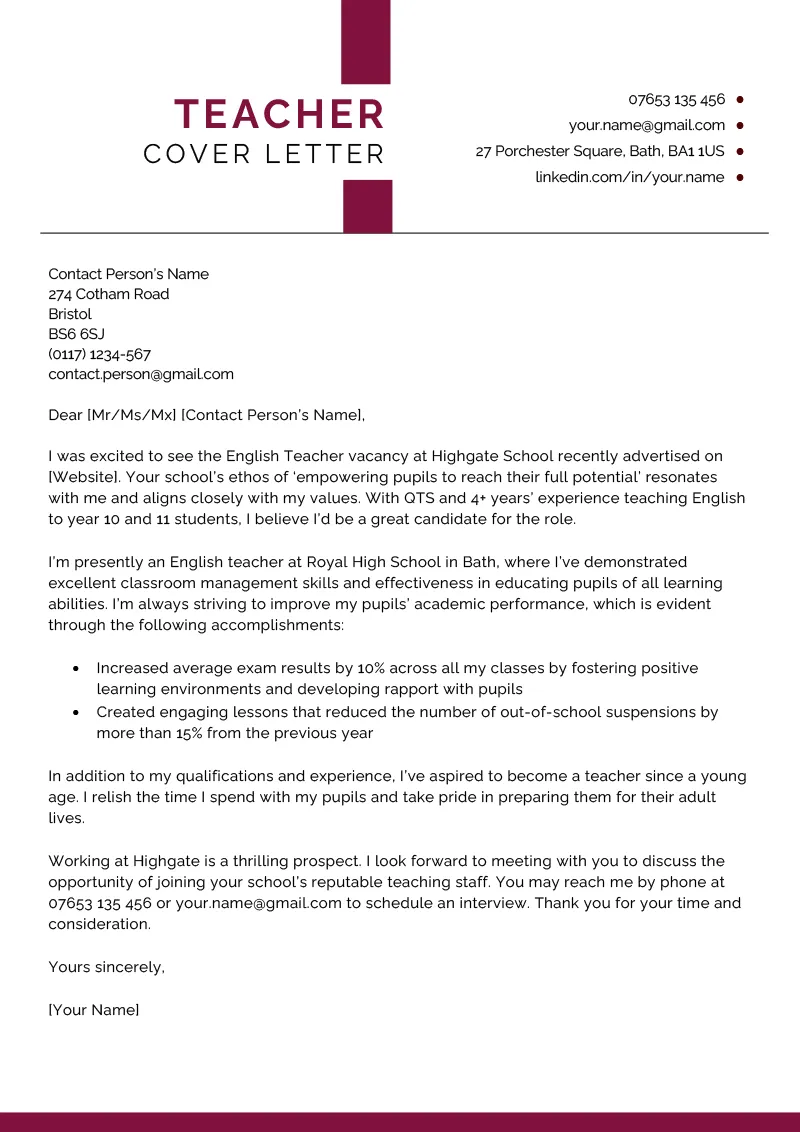
Classroom management is pivotal to a successful teaching environment, so highlighting your abilities in this area is essential. Your cover letter should clearly illustrate your strategies for creating a positive and productive learning atmosphere. Describe the specific techniques you use to establish clear expectations and maintain discipline. Do you implement any particular classroom rules or routines? If so, detail how these contribute to a structured and respectful learning environment. Provide examples of how you handle challenging student behaviors, emphasizing your use of proactive measures to prevent disruptions. Do you have experience with restorative justice practices or positive behavior interventions and supports (PBIS)? If yes, be sure to explain how you have used these strategies to foster a supportive and inclusive classroom. Remember, the hiring committee is looking for teachers who can create a safe and engaging space where students can thrive. Show them you have the skills to do just that.
Emphasizing Your Curriculum Knowledge
Your understanding of the curriculum and your ability to create engaging lessons are critical aspects to highlight. In your cover letter, demonstrate that you have a strong grasp of the subject matter and an ability to translate complex information into accessible and engaging lessons. If the job description specifies particular curriculum requirements (e.g., Common Core, IB), emphasize your experience and familiarity with those standards. Describe how you develop lesson plans that align with these standards while also catering to diverse learning styles. Do you integrate technology, project-based learning, or other innovative methods into your teaching? Provide concrete examples of successful lessons and projects that you have designed and implemented. Show the hiring committee that you are passionate about your subject and that you can effectively convey this passion to students. Mention any specializations or certifications you have that are relevant to the position, such as a reading specialist certification or experience with special education.
Demonstrating Your Passion for Education
Your cover letter should clearly communicate your enthusiasm for teaching and your dedication to student success. Express your genuine passion for education by sharing your reasons for entering the profession. What motivates you to be a teacher? What do you love about working with students? Show that you are not just looking for a job, but that you are committed to making a positive impact on young lives. Include specific examples of how you have gone above and beyond to support your students, whether it involves mentoring, tutoring, or creating extracurricular activities. Demonstrate your understanding of the school’s mission and values, and explain how your own educational philosophy aligns with theirs. Express your excitement about the opportunity to contribute to their community and to help students achieve their full potential. A passionate cover letter will make you stand out from the crowd and show the hiring committee that you are a committed and enthusiastic educator.
Formatting Your Teacher Cover Letter
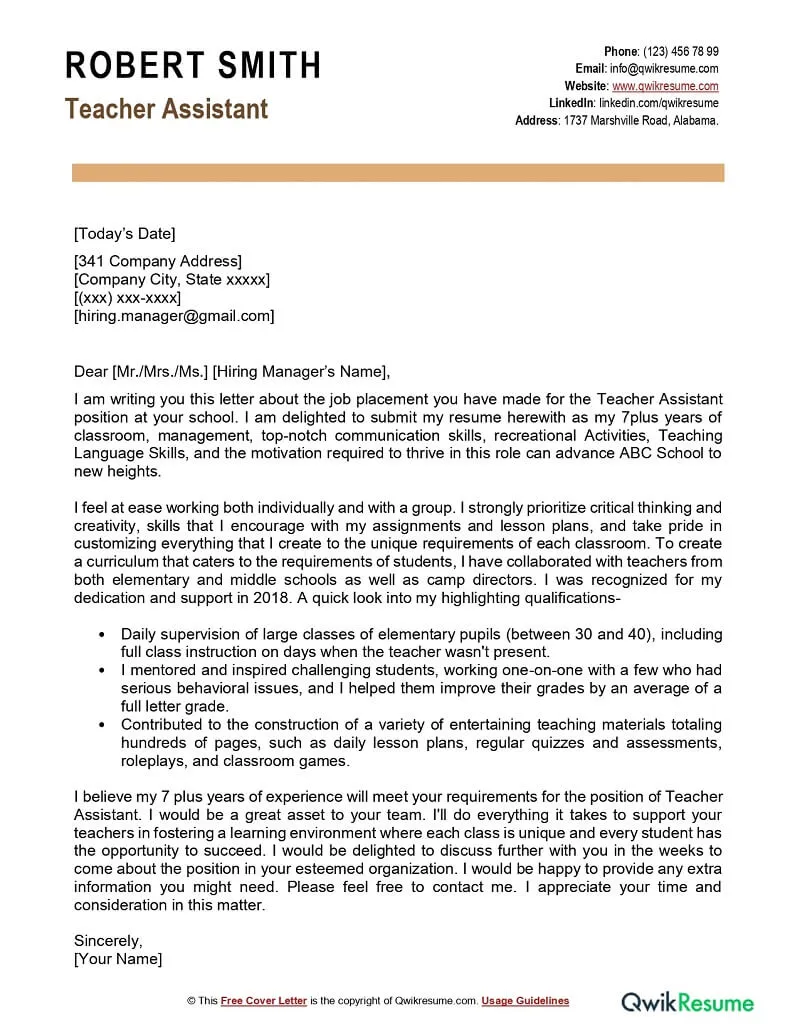
The format of your cover letter is just as important as its content. A well-formatted letter is easy to read and visually appealing. Use a professional-looking font like Times New Roman, Arial, or Calibri, and maintain a font size of 11 or 12 points. Keep your margins at 1 inch on all sides. Use single spacing within paragraphs and double spacing between paragraphs. The cover letter should typically be no more than one page in length. Ensure your letter has a clear structure, including a header, a greeting, an introduction, body paragraphs, a closing, and a signature. Proofread your letter meticulously to eliminate any grammatical errors or typos. Use bullet points and concise paragraphs to enhance readability and highlight key information. Make use of bolding and underlining to emphasize important points but avoid overusing these formatting options.
Header and Contact Information
Start your cover letter with a header that includes your full name, address, phone number, and professional email address. Make sure your email address is professional; avoid using nicknames or casual language. You may also include a link to your online portfolio or professional website, if you have one. Ensure your contact information is up-to-date and accurate. This information should be clearly visible at the top of the page, making it easy for the hiring manager to contact you. Align this information to the left or right, depending on your preference, but be consistent with your formatting throughout the document.
Greeting and Introduction
Begin your cover letter with a formal greeting, such as “Dear Mr./Ms. [Last Name],” or, if you are unsure of the hiring manager’s name, use “Dear Hiring Committee.” In your introduction, state the position you are applying for and briefly explain where you saw the job posting. Then, provide a brief and engaging overview of your relevant experience and skills, and state why you are interested in the position and the school. Make sure your introduction is concise and captures the reader’s attention. This is your first opportunity to make a strong impression, so use it to highlight your most relevant qualifications and express your enthusiasm for the opportunity. Tailor your greeting to match the school’s culture; if the school seems more casual, a less formal greeting might be appropriate.
Body Paragraphs (Skills & Experience)
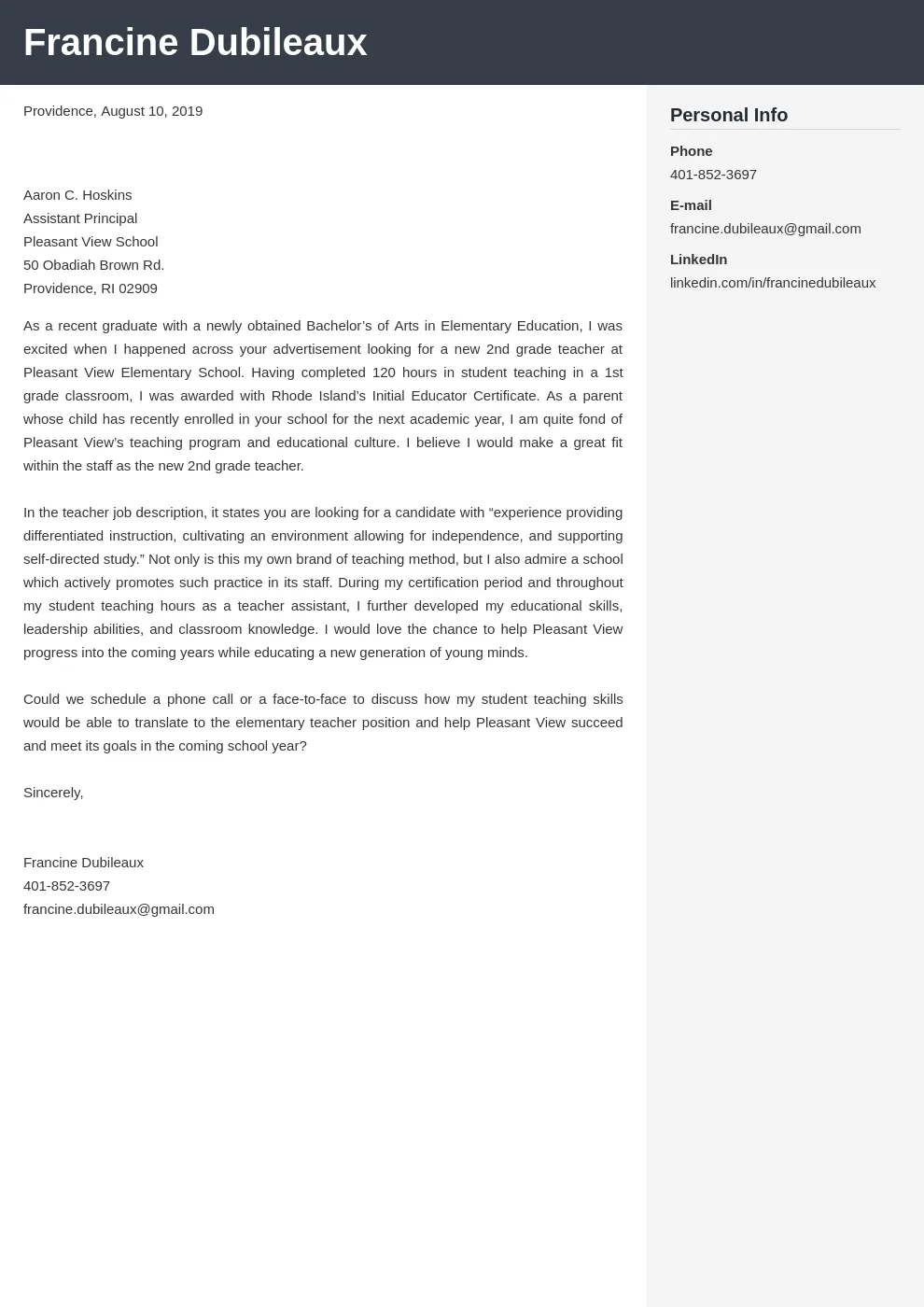
The body of your cover letter is where you provide detailed information about your skills and experience. Structure your paragraphs logically, focusing on specific examples that support your claims. Use the STAR method (Situation, Task, Action, Result) to provide concrete evidence of your achievements. For each skill or experience you highlight, explain the situation you were in, the task you were assigned, the actions you took, and the positive results you achieved. This approach not only demonstrates your skills but also shows the impact of your work. Make sure to align your qualifications with the requirements outlined in the job description. Prioritize the skills and experiences that are most relevant to the position and the school’s specific needs. Include quantifiable results whenever possible, such as improved student test scores, increased student engagement, or successful implementation of new teaching strategies. Use concise and clear language to convey your message effectively.
Tailoring Your Letter to the School
One of the most effective strategies is to tailor your cover letter to the specific school and position. Before you begin writing, thoroughly research the school. Visit their website, read their mission statement, and learn about their values and programs. Mention specific aspects of the school that appeal to you, and explain how your skills and experience align with their needs. Address the unique qualities of the school in your letter, such as their focus on technology, their commitment to diversity, or their specific teaching methodologies. If the job description mentions a particular skill or experience, make sure to highlight your related qualifications. Show the hiring committee that you have taken the time to understand their school and that you are genuinely interested in joining their team. Avoid using generic language or sending the same cover letter to multiple schools; instead, personalize each letter to reflect the individual requirements of each position.
Closing and Call to Action
In your closing paragraph, summarize your key qualifications and reiterate your interest in the position. Thank the hiring manager for their time and consideration. Include a call to action, such as requesting an interview or expressing your eagerness to discuss your qualifications further. Make sure to provide your contact information again, in case it gets separated from the header. Be professional and enthusiastic in your closing. You can end with a standard closing like “Sincerely” or “Best regards,” followed by your typed name. If you are sending a physical copy, leave space for your signature above your typed name. Your closing paragraph should leave a positive and memorable impression on the reader, encouraging them to take the next step in the hiring process.
Proofreading and Editing Your Cover Letter
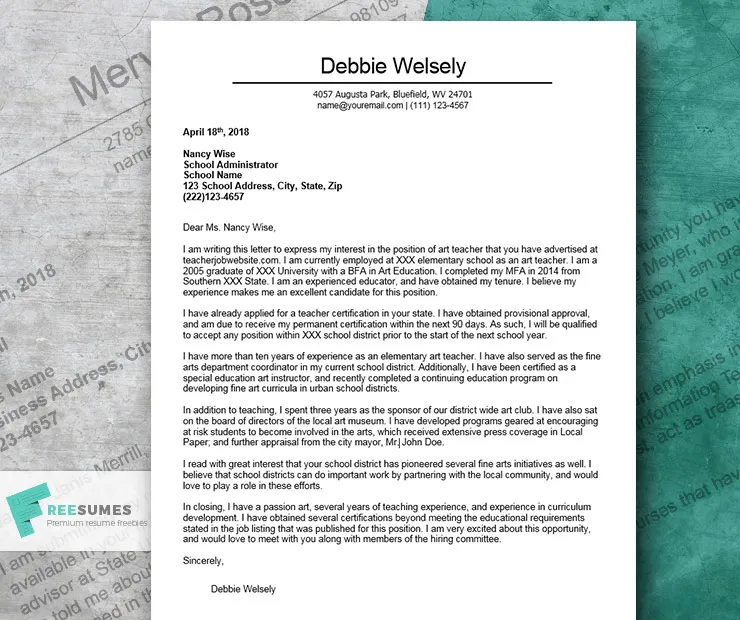
Before you submit your cover letter, thoroughly proofread and edit it to catch any errors. Typos, grammatical errors, and inconsistencies can create a negative impression and undermine your credibility. Read your letter aloud to identify awkward phrasing or unclear sentences. Check for spelling and grammatical errors using a spell checker and grammar checker. Have a trusted friend or colleague review your letter, as a fresh pair of eyes can often spot mistakes that you might miss. Pay attention to the formatting of your letter, ensuring that it is consistent and professional. Make sure your contact information is accurate. Proofreading is a critical step in the application process, so take the time to ensure your cover letter is polished and error-free. A well-written, error-free cover letter demonstrates your attention to detail and professionalism.
Common Mistakes to Avoid in Teacher Cover Letters
Generic Language
Avoid using generic or vague language in your cover letter. Phrases like “I am a hard worker” or “I am passionate about teaching” are too general and do not provide any specific information about your skills or experience. Instead, provide concrete examples and specific details to support your claims. Use action verbs to describe your accomplishments and quantify your results whenever possible. Tailor your language to the specific school and position you are applying for. Show the hiring committee that you have put in the effort to understand their needs and that you are not simply sending a generic cover letter to multiple schools.
Focusing on Yourself Too Much
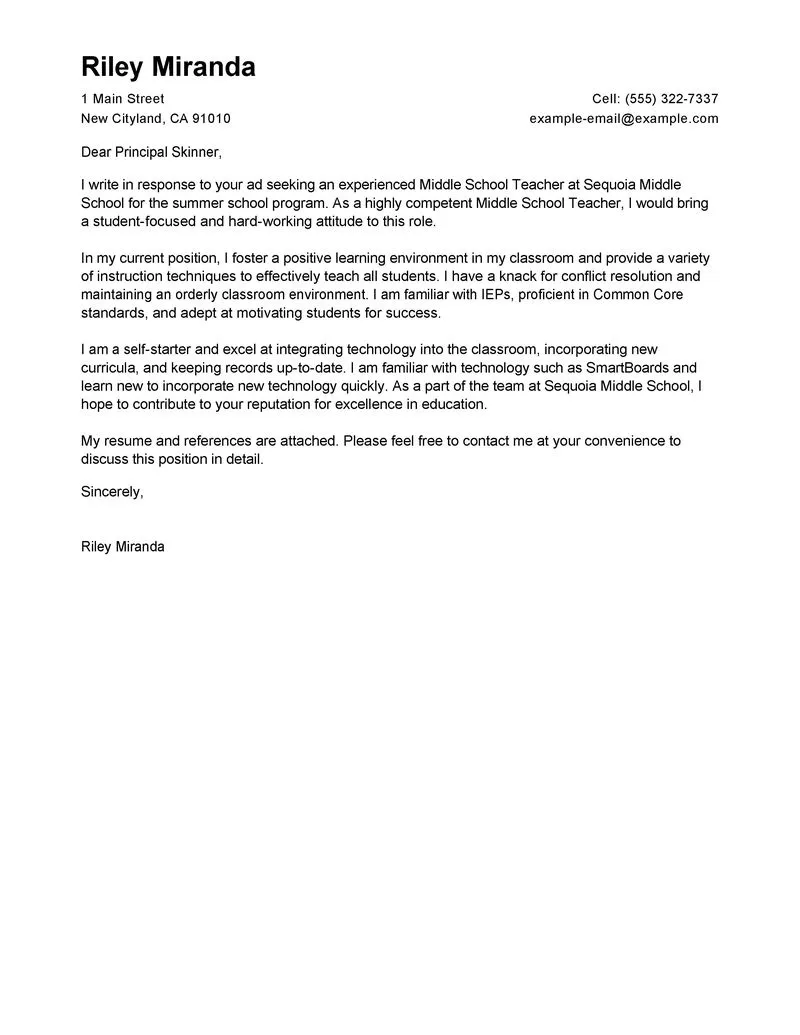
While it’s important to showcase your skills and experience, avoid making your cover letter all about you. Instead, focus on how your skills and experiences can benefit the school and its students. Demonstrate how your teaching philosophy aligns with the school’s mission and values. Explain how you will contribute to the school community and help students achieve their goals. The hiring committee is interested in what you can do for them, so frame your accomplishments in a way that emphasizes your potential to make a positive impact. Balance your self-promotion with a focus on the school’s needs and the students’ success. Remember, the goal is to show how you can be a valuable asset to their team.
Ignoring the School’s Needs
One of the most significant mistakes is failing to address the school’s specific needs and requirements. Make sure to carefully review the job description and address the skills and experiences that the school is seeking. Research the school’s mission, values, and programs, and tailor your cover letter to reflect your understanding of their specific needs. Demonstrate how your qualifications align with their requirements. Avoid sending a generic cover letter that does not mention the school or position you are applying for. Show the hiring committee that you have taken the time to understand their school and that you are genuinely interested in the opportunity. Addressing the school’s needs is crucial for making a strong impression and demonstrating that you are a good fit for their team.
Lack of Enthusiasm
Your cover letter should express genuine enthusiasm for the teaching position and the opportunity to join the school community. Avoid sounding indifferent or uninspired. Show that you are passionate about education and committed to making a positive impact on students’ lives. Share your reasons for wanting to be a teacher and what motivates you. Highlight your excitement about the school’s mission and values. Demonstrate your interest in the specific position and explain why you believe you are a good fit. A passionate and enthusiastic cover letter will make you stand out from other applicants and leave a memorable impression on the hiring committee. Inject your personality and let your excitement shine through.
Final Tips for a Winning Teacher Cover Letter
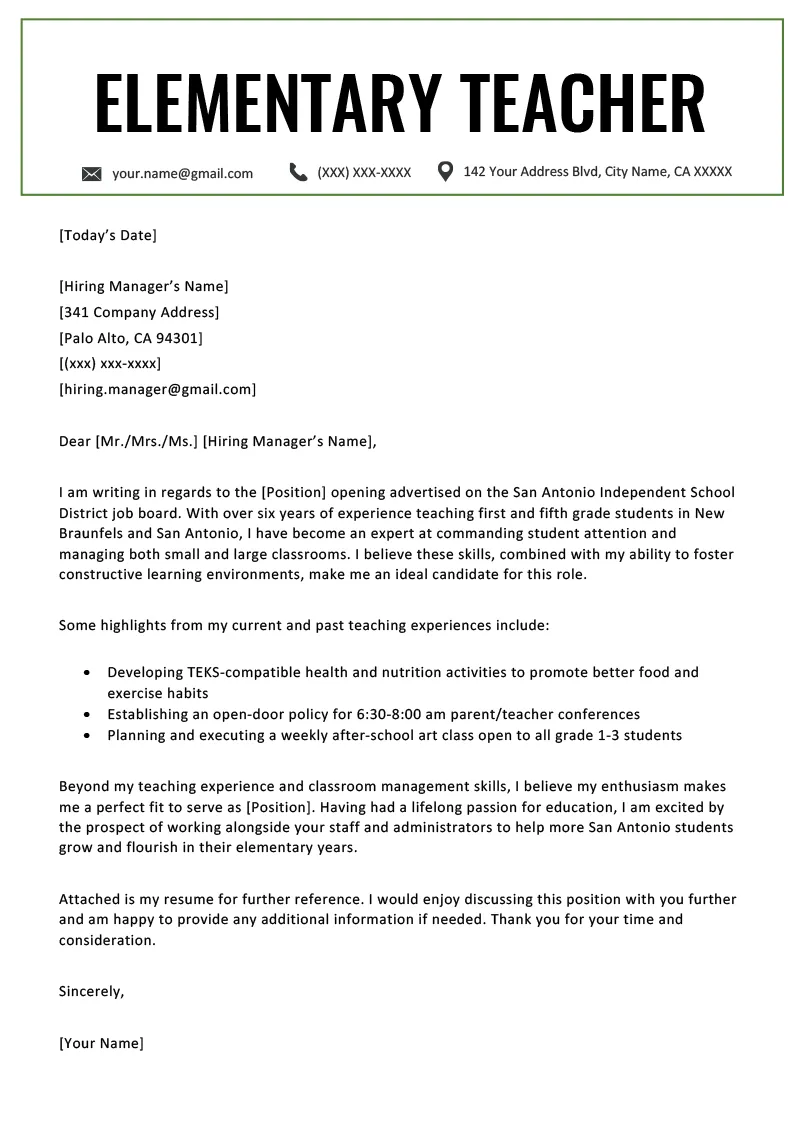
Follow these final tips to maximize your chances of success. Always customize your cover letter for each application, tailoring it to the specific school and position. Highlight your unique strengths and skills that align with the job requirements. Use a professional and easy-to-read format, ensuring your letter is well-organized and error-free. Proofread your letter meticulously to catch any typos or grammatical errors. Get feedback from a trusted friend or colleague before submitting your application. Be sure to submit your cover letter and resume in a timely manner, following the instructions provided by the school. By following these tips and avoiding common mistakes, you can create a compelling cover letter that will help you secure an interview and land your dream teaching job. Remember, your cover letter is your first impression, so make it count!
